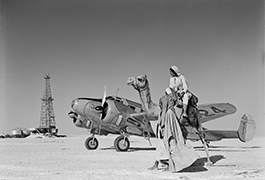
Wildcat well, Beechcraft airplane, and camel, 1946
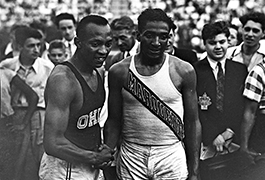
Jesse Owens and Ralph Metcalfe at the 1936 Randall's Island Olympic trials
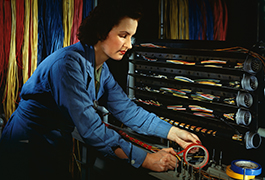
[Worker assembling wire,
Chrysler], 1944
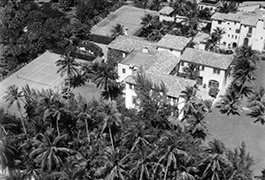
Amado and Louwana, Palm Beach, FL, ca. 1930-1934
![Hortonspheroids at Lake Creek [Field] recycling plant, Superior Oil Co.](/-/media/Site/Libraries/digital-collections/ryr/ryr_slideshow_spheroids.jpg)
Hortonspheroids at Lake Creek [Field] recycling plant, Superior Oil Co., ca.1949
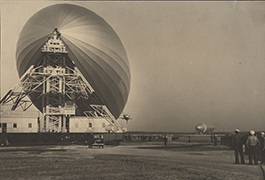
[The Hindenburg, with second airship in background, Lakehurst, NJ], 1936
![[Models with Oldsmobile Automobile, Lockheed 10B Electra, Delta Air Lines]](/-/media/Site/Libraries/digital-collections/ryr/ryr_slideshow_lockheed.jpg)
[Models with Oldsmobile Automobile, Lockheed 10B Electra, Delta Air Lines], 1940
About the Collection
Holding library: DeGolyer Library
View more collections held by DeGolyer Library
Overview
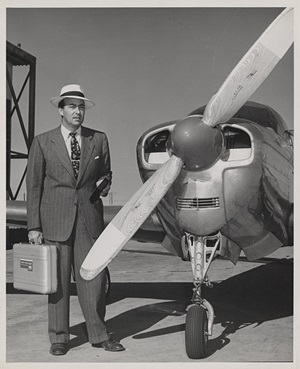
Robert Yarnall Richie (1908-1984) worked as a free-lance commercial and industrial photographer for many large corporations including those in the automobile, aviation, chemical, mining, petroleum, railroad, shipping, steel and other industries, both in the U.S. and overseas. Richie's work is significant for its artistic qualities as well as documentary information.
The
Robert Yarnall Richie Photograph Collection, held by the DeGolyer Library, contains corporate and industrial photographs made by Richie from 1932-1975. The digital collection is arranged by
negative number (see below) and Series.
A finding aid for the collection is available in TARO.
Collection Materials
Richie often worked for Fortune, Life, Scientific American, The American Magazine, Time, National Geographic and other magazines, in addition to illustrating annual reports for Fortune 500 companies including General Motors, U.S. Steel, Gulf Oil, Phelps Dodge, and Dresser Industries among many others.
Richie further branched out into shooting oil production images in such areas as Texas, Louisiana, the Gulf of Mexico, and Saudi Arabia. Richie expressed a preference for oil work, “There’s drama in steel, but there’s more romance in oil,” he said, “oil has so many different angles to it as an industry. Oil really has a story to tell in pictures.” 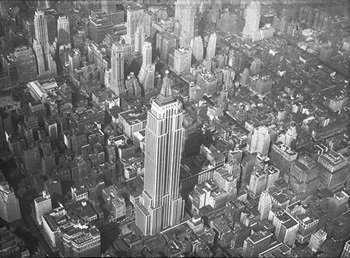
An avid pilot, Richie's work also contains thousands of aerial
photographs from many locales, including hundreds of estates and clubs in Palm Beach, FL, Long
Island, NY, Newport, RI, and other wealthy suburbs. Other aerials include well-known
buildings in New York City, as well as bridges and other landmarks.
As a pioneer in the field, he excelled in making artistic views of corporate industrial subjects in a mid-century modernist style. Richie often took unusual angle shots creating dramatic photographs of what could have been mundane subjects.
Holdings and Highlights
The digital collection is arranged by Negative Series number. In general, the Negative Series number for each negative or print is chronological, i.e. lower numbers were created earlier in Richie's career than higher numbers. However, the physical collection comprises 8 Series, arranged by subject and size. Below is a listing of each Series with links to items that have been digitized.
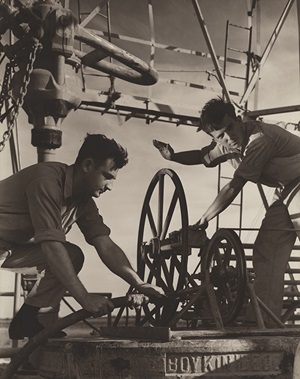
- Series 1: Prints mostly consists of smaller black and white photographic prints: 4 x 5, 5 x 7, 8 x 10, and 11 x 14-inches. In the higher negative number series, there are also some color transparencies and color negatives.
- Series 2: Contact prints mounted on client job cards consists of black and white contact prints mounted on client job cards. The client job cards are arranged by negative number and have contact prints mounted on board with information regarding the company for whom Richie was making the photographs, location and date.
- Series 3: Color slides, color transparencies, and 8 x 10 inch negatives contains color slides and transparencies, both 35mm and 2 ¼ by 2 ¼-inch.
- Series 4: Manuscripts consists of manuscripts including some correspondence, client release forms, magazine clippings, personal photographs of Richie, and a scrapbook entitled, Eyes on Richie.
- Series 5: Prints, oversize contains oversized prints.
-
Series 6: Negatives and color transparencies is made up of negatives. The negative sleeves often have important information about the client, location and date the negatives were made. Most of the negatives are black and white 4 x 5-inch, but there are substantial numbers of 5 x 7, and some 35mm and 2 ¼ by 2 ¼-inch. The “E” after negative numbers stands for color Ektachrome film.
- Series 7: Motion picture film consists of motion picture film reels in various formats.
- Series 8: Client list is a listing of Richie’s clients mainly taken from his index cards arranged alphabetically by client giving the date, and location of work.
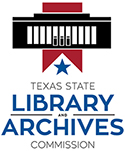 Grants
Grants

A total of 2,304 photographs of Texas industry, 1936-1970, were made available from grant funds. In FY2013 digitization of 1,238 of Richie's Texas-oil-related photographs was funded by the TexTreasures program. A follow-on grant in FY2014 supported the digitization of 1,066 non-oil related Texas photographs. The TexTreasures program is funded by the Institute of Museum and Library Services through a grant to the Texas State Library and Archives Commission. The Institute of Museum and Library Services is the primary source of federal support for the nation’s 123,000 libraries and 17,500 museums. The Institute's mission is to create strong libraries and museums that connect people to information and ideas.
See more items from the 20th Century in these other collections from DeGolyer Library:
Copyright usage terms vary throughout the collection. Each item contains information about usage terms. If SMU does not have the right to publish the item on the Internet, only the item's metadata will be available and the digitized object will be available on a restricted access basis. Such items may only be viewed on campus. When items are available for use, please cite DeGolyer Library, Southern Methodist University. A high-quality version of these files may be obtained for a fee by contacting degolyer@smu.edu.